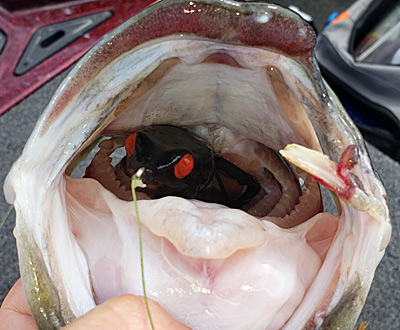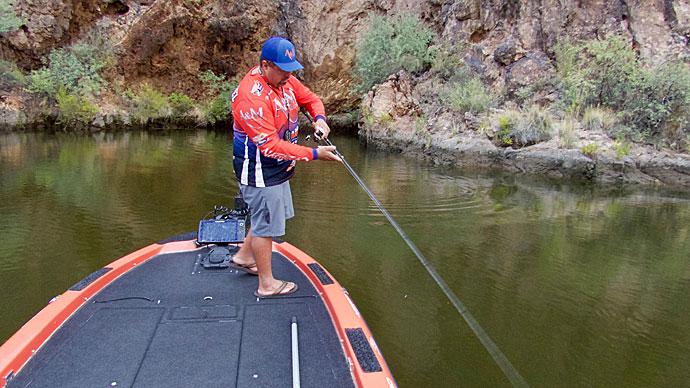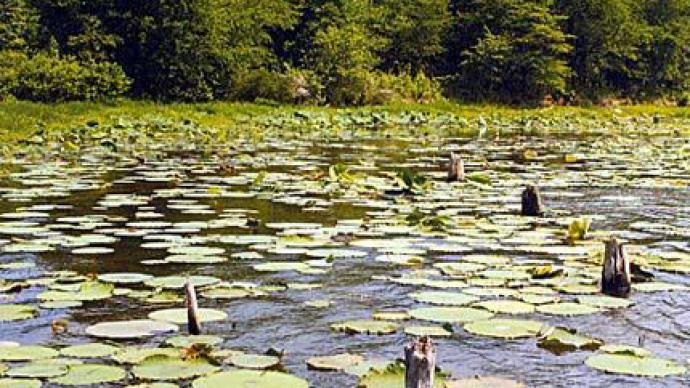
The hollow-body topwater frog has been around for decades and remains one of the most exciting ways to catch a bass. Originally they were developed for fishing in the summer heat on the top of matted vegetation and around lily pads, the habitat of frogs. They continue to catch many bass that way every year, but as the frog has exploded in popularity in the past few decades, the lure has become more refined, and anglers are using them in more situations.
Also changing over the years is the availability of new sizes of frogs and baits that pop, walk, and plop. No matter what frog you select, they are a fun way to catch both numbers of fish and big bass.
Frog Types
One of the first things to consider is the type of frog you plan to use. The three major categories are the standard frog, a popping frog, and added attachments to the rear to give it a different look and action, such as a plopping tail or some added attraction.

The standard frog is a weedless body with skirted legs. They feature a double-hook design and are great for working on top of the thick matted cover. This design also lets you “walk” the frog in a similar way as you do with a walking topwater bait like a Zara Spook.
Just about every lure manufacturer makes the popping versions of frogs, and these frogs add the appeal of a popping noise and can also match the action of small bluegill and other baitfish that eat bugs on the surface. Popping frogs are excellent choices for sparse vegetation and open water and are not the best when fishing matted vegetation.
The third type of frog is those with the added attachments to the rear that plop, buzz, or spin. They do best in more open water as the attachments can quickly grab pieces of vegetation. They are also unique as a standard cast, and retrieve is all you need to impart action. Just adjust the speed faster or slower, depending on the activity of the fish that day.
With all three types of frogs, waiting until you feel the weight of the fish before setting the hook is critical instead of just watching the surface splash. Timing the hookset is one of the most significant learning curves when getting started with frog fishing. Training yourself to wait will significantly increase your hookup percentage.
The When and Where
If this article were written years ago, it would have likely started and ended with saying to fish a frog around matted vegetation in the summer months. As the frog has evolved and become more popular, anglers have learned they will work much earlier in the year and around all types of cover.

Starting in the immediate pre-spawn period, when the water temperatures reach the mid 50’s-degree mark, a frog becomes an effective way to catch bass. On the other side of the spectrum, they will perform when the water drops to that temperature when the fall and winter seasons begin.
Vegetation is still king for frogs, and lily pads, hydrilla, milfoil, and any other type of grass that reaches the surface will be good places to throw a frog. You can add in docks, overhanging trees, and open water to get your next frog bass.
Frog Modifications
Most frogs can catch bass right out of the package, but you can make a few minor tweaks to increase your hookup percentage, change the action, and make them more appealing to bass.
One of the downsides of any frog is that you will never catch every bass that strikes your frogs. Blowups and missed fish are part of the game, but by modifying your hook slightly, you can land more fish. You will increase your chances of hooking fish by slightly bending out the hooks. The downside of this is that the bait will lose some of the weedless and snagless properties.
Trimming the legs of a frog is another common practice and comes down to personal preference and what you want the frog to do. Some brands come with long strands of rubber material; cutting them back an inch or two is a good idea. Also, by cutting one side shorter than the other, you can obtain a better walking action from the bait.

Another trick some anglers do to add to their frogs' appeal is inserting a small glass rattle or even a tiny metal craft bell inside the hollow cavity. This adds sound and lets fish “zone in” on the bait even when they are beneath a canopy of vegetation.
Color Thoughts
Frogs come in all shapes, sizes, and colors, but keeping your color selection simple is a great way to go. Having a collection of dark-colored baits and those with light undersides is all you need. If you were to pick two, a solid black and a solid white would suffice and cover just about every situation you find yourself in on the water.
Froggin’ Gear
Frog fishing is typically done on baitcasting gear due to the dense cover they are usually fished around, but a heavier spinning outfit may work in a pinch. Rod size and action come to personal preference, but most anglers prefer a heavy action between seven and 7’6” long. Some anglers prefer a medium-heavy to allow them to work the bait better from side to side, but you will sacrifice some power when fighting big bass.
One almost mandatory thing is a braided line, as it will help pull fish in that are often covered in grass. It will also help you reduce break-offs and ensure you don’t lose your next giant bass. 50 to 65-pound braided line such as Seaguar Smackdown in the Stealth Gray color is a great choice. Add it to a high-speed reel around 7.1:1, and you are ready to go. The faster retrieve helps pick up line quickly and keeps you in a better position to work the bait effectively.
There is a reason frog fishing is so popular, it is exciting, and you have a great chance at catching above-average-sized bass. They work in various situations, and nothing beats an excellent topwater frog blowup.




